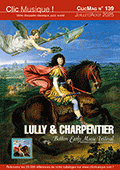 A la Noël 1660, c'est un Schütz de 75 ans, au sommet de son art et de sa gloire, quoique mal payé, qui donne à la cour de Dresde un de ses chefs d'oeuvre, « L'histoire de la naissance joyeuse et gracieuse de Dieu et du Fils de Marie de Jésus-Christ », dédiée au prince-électeur Johann Georg II. Par sa portée et ses dimensions, cette œuvre remarquable déploie une grande variété de couleurs instrumentales et vocales pour caractériser les épisodes successifs du récit, tiré des évangiles de Luc et Matthieu. Ce n'est qu'en 1664 qu'il en fera imprimer les seuls récitatifs, dans un « stile recitativo » dont il soulignait qu'il était « nouveau, et, jusqu'à présent, jamais publié en Allemagne ».Le reste, les « Intermèdes », devant être adapté aux moyens des ensembles qui les joueraient, était à se procurer auprès d'autres musiciens. Le style de Schütz a évolué : Sans renier ses leçons italiennes, il renoue avec la tradition de la polyphonie franco-flamande. Pleine de fraîcheur et d'allégresse, cette œuvre, par l'alternance de récitatifs (avec basse continue), d'airs à plusieurs voix et de choeurs, préfigure les oratorios et Passions de Bach. De nos jours, plusieurs ensembles ont tenté de reconstituer toute l'oeuvre à partir des bribes qui nous en sont parvenues. C'est un choix différent qu'ont fait Alexander Schneider et son Ensemble Polyharmonique : Celui d'insérer dans la trame de Schütz des morceaux écrits par une quinzaine de compositeurs allemands du XVIIème siècle, dont les moins méconnus se nomment Hammerschmidt, Rosenmüller, Praetorius, Scheidt, Schein...On aurait pu craindre un sentiment d'hétérogénéité. Il n'en est rien, grâce à la qualité de l'interprétation : C'est une guirlande de musiques sacrées en terre luthérienne que nous offre l'Ensemble Polyharmonique, un florilège de chefs d'oeuvre de la musique baroque allemande. (Marc Galand)  During the seventeenth century the historia developed in Protestant church music as a genre telling the Easter, Passion, and Christmas stories in the words of Luther’s Bible. The Dresden chapel master Heinrich Schütz, who was renowned far and wide already during his lifetime, drew on this form as early as 1623. And when he had his Weihnachtsthistorie published in 1664, it replaced the older historia in the setting by Rogier Michael, Schütz’s predecessor as chapel master, though Schütz retained most of Michael’s text. As manifold tractates and introductions in printed music of the seventeenth century often indicate, the works to be performed are to be presented in keeping with the circumstances and resources available in the performance location. Accordingly, Schütz also let it be known in his introduction to the Weihnachtshistorie that he »left it open [to composers] to set these ten concertos (whose texts are also to be found in these printed pages) in a manner pleasing to them and for the corpus musicum available to them, either entirely anew by themselves in a different way or to have them composed by others.« This idea inspired the members of the Polyharmonique ensemble to produce an alternative version of the Weihnachtshistorie that would be practicable for their particular ensemble. The resultant HISTORIA NATIVITATIS strictly follows the formal intention of »Sagittarius Schütz« and was set for a »corpus musicum« of six voice parts, two violins, curtal, and a colorful basso continuo (organ, regal, theorbo, Baroque harp, violone). Contemporary sources, primarily from Central Germany, some of them otherwise unknown compositions by Andreas Hammerschmidt, Samuel Scheidt, Wolfgang Carl Briegel, Johann Georg Carl, Stephan Otto, and others, that exactly follow the source texts are extant. What we have before us is a historia such as might have been heard at a Christmas vespers service in Central Germany during the seventeenth century. It combines magnificent art music with traditional Christmas melodies of Central German provenance and during its course is transformed into a spirited oratorio, interpreted here by the famous Polyharmonique ensemble with attention to historical performance practice.
 |
